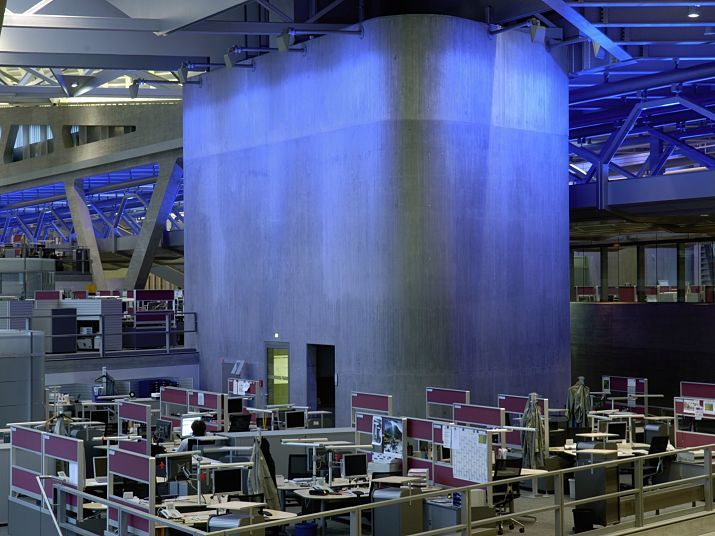
Wall lighting can fulfil a number of tasks. Firstly, it can be aimed at fulfilling vertical visual tasks on the walls, whether this be informative material such as notice boards, presentational objects such as paintings or merchandise, architectonic structures or the surface of the wall itself. Wall lighting can, however, also be aimed solely at presenting the wall in its capacity as the surface delineating the room; finally, wall illumination can be a means of indirect general lighting for a room.

Wall, 3m

Wall, 5m

Wall with texture
Wall, 3m
Observation
Wallwasher spotlights offer flexible adjustment for different wall heights. Wallwashers are characterised by the even progression of brightness along the wall.
Lens wallwashers have special lens reflector systems. Washlights project the light evenly onto the wall surface, while maintaining the downlight effect on the room.
Linear light sources for wallwashing with fluorescent lamps provide a perfectly even brightening of the wall.
Using a Softec lens, an extremely even illumination of the whole wall can be achieved, even in the higher area right up to the ceiling. The perimeter illumination out of a haunch is positioned directly on the wall.
It produces a grazing light effect and emphasises the surface texture.
The evenness of the wallwashing is only secondary here.
Conclusion
The room is made to look bigger by brightening its walls and ceiling etc.
Point light sources make the wall surface much more vivid, whereas with linear luminaires a higher uniformity is achieved.
Lighting criteria for walls:
- uniformity of the lighting
- the choice of lamp determines the light colour and colour rendition
Arrangement


Alternatively, the offset from the wall is where a 20 degree line projected from the base of the wall intersects the ceiling.
An optimum evenness is obtained when the luminaire spacing is the same as the offset from the wall.
Wallwashers only develop their optimal evenness as of a minimum number of three luminaires.
The position of a wallwasher in a room corner should lie on the 45° line
Washlighting illumination for vertical surfaces of:
- museums
- exhibitions
- trade-fair stands
- sales and representational areas
Preferred luminaire groups
- wallwashers
- washlights
- lens wallwashers
- double washlights
- perimeter luminaires
British Museum, London
Crescent House, Wiltshire
Museum Punta della Dogana, Venice
Weimar College of Music
Wall, 5m
Observation
As the room height increases the brightness of the wall decreases, if the lighting remains constant. Wallwashers are characterised by the even progression of brightness along the wall.
Lens wallwashers have special lens reflector systems. Linear light sources for wallwashing with fluorescent lamps provides a perfectly uniform brightening of the room.
Using a Softec lens, an extremely even illumination of the whole wall can be achieved even in the higher area right up to the ceiling. The perimeter illumination out of a haunch is positioned directly on the wall.
It produces a grazing light effect and emphasises the surface texture.
The evenness of the wallwashing is secondary.
Vertical illumination emphasises the walls - or other room limits - in terms of their physical makeup.
The room is made to look bigger by brightening the wall faces.
Point-form light sources make the wall surface much more vivid while with linear luminaires a higher uniformity is achieved.
As the room height increases the distance of the luminaire to the wall must be increased.
The reduction of the mean illuminance in higher rooms can be compensated for by having a higher lamp power and by increasing the number of luminaires. Wallwashing only produces an even brightness on matt surfaces.
Lighting criteria for high walls
- uniformity of the lighting
- the choice of lamp determines the light colour and colour rendition
Wall 5m Position


The offset from the wall is where a 20 degree line projected from the base of the wall intersects the ceiling.
The position of a wallwasher at the end of the wall should lie on the 45 degree line.
Washlighting illumination for vertical surfaces in:
- museums
- exhibitions
- trade-fair stands
- sales and representational areas
Preferred luminaire groups
- wallwasher
- washlights
- lens wallwashers
- perimeter luminaires
Heart of Jesus Church, Munich
Bank of China, Beijing

BMW factory, Leipzig
Martin-Gropius building, Berlin
Observation
Point-form wallwashers make surface textures clearly visible. When using linear light sources the wall face appears even and the surface texture is only emphasised to a limited extent. When using perimeter luminaires mounted directly on the wall, there is no evenness and great vividness is created.
Linear light sources at a short offset from the wall most vividly enhance the surface texture. Conversely, point-form light sources at a short offset from the wall produce their own light pattern that, admittedly, does accentuate the texture, but does not permit an even wallwashing. Grazing light on walls can accentuate any surface irregularities.
Applications
The smaller the offset from the wall, the clearer the surface texture is enhanced. When using grazing light, the evenness of the wall illumination is greatly reduced.
Preferred luminaire groups
- wallwashers
- washlights
- lens wallwashers
- perimeter luminaires
Bodegas Portia, Gumiel de Izán

Neues Museum (New Museum), Berlin
ABN AMRO, Sydney
Heart of Jesus Church, Munich





